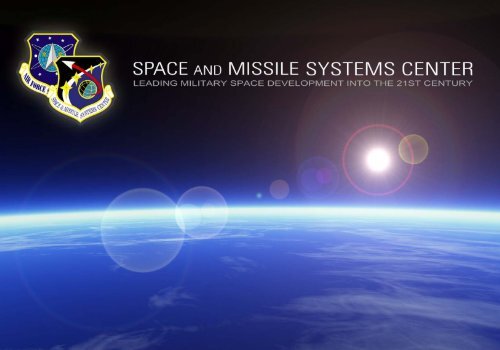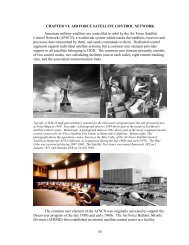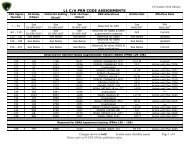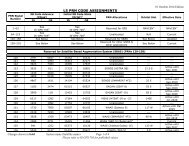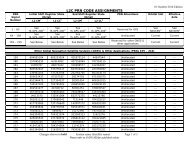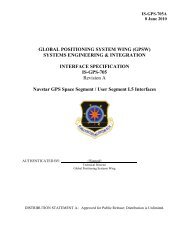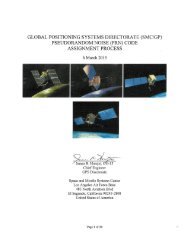(SMC). - Los Angeles Air Force Base
(SMC). - Los Angeles Air Force Base
(SMC). - Los Angeles Air Force Base
You also want an ePaper? Increase the reach of your titles
YUMPU automatically turns print PDFs into web optimized ePapers that Google loves.
INSIDE “SPREAD”
SPACE AND<br />
MISSILE SYSTEMS CENTER<br />
THE <strong>SMC</strong> STORY<br />
Mission & Vision ................................. p.1<br />
Center Heritage .................................. p.3<br />
Current Responsibilities ...................... p.5<br />
Mission Areas ..................................... p.7<br />
Functional Expertise ........................... p.9<br />
Integrated Approach ......................... p.11<br />
Way Ahead ....................................... p.13<br />
Core Values ...................................... p.15<br />
The Future ........................................ p.17
SPACE AND<br />
MISSILE SYSTEMS CENTER<br />
INTRODUCTION<br />
The Space and Missile Systems Center (<strong>SMC</strong>) is<br />
the <strong>Air</strong> <strong>Force</strong>’s product center for the development<br />
and acquisition of space and missile systems. The<br />
Center was established in 1954 and has served as<br />
the leader in military space systems development<br />
since the earliest days of the space age. Today<br />
<strong>SMC</strong> leads the development, acquisition, fi elding,<br />
and sustainment of the world’s best military space<br />
and missile systems. The systems <strong>SMC</strong> develops<br />
and acquires enable <strong>Air</strong> <strong>Force</strong> Space Command<br />
(AFSPC) to deliver unparalleled capabilities to<br />
national decision makers, asymmetric operational<br />
advantages to joint warfi ghters, and economic and<br />
technological benefi ts to the nation. As a widely<br />
respected and trusted provider of critical military<br />
space and missile systems, <strong>SMC</strong> supports <strong>Air</strong><br />
<strong>Force</strong> Space Command in enhancing national<br />
security and shaping how our nation fi ghts and<br />
wins its wars.<br />
This document describes <strong>SMC</strong>’s mission, history, organization, responsibilities, management processes, and organizational culture. The<br />
document illustrates both how <strong>SMC</strong> develops and acquires cutting-edge military space and missile systems across a broad spectrum<br />
of mission areas, assigned programs, and areas of responsibilities and how <strong>SMC</strong> plays a role as a major actor in the nation’s overall<br />
space community. The document begins by defi ning the core mission and vision of <strong>SMC</strong> and discussing the Center’s evolution to its<br />
current organization. It then highlights <strong>SMC</strong>’s responsibilities, mission areas, functional expertise, and integrated management approach. It<br />
concludes by looking forward to the priorities and enduring values that will shape the future of the Space and Missile Systems Center and<br />
the <strong>Air</strong> <strong>Force</strong>’s joint space warfi ghting capabilities.
SPACE AND<br />
MISSILE SYSTEMS CENTER<br />
MISSION & VISION<br />
The Space and Missile Systems Center is responsible for managing cutting-edge space systems across their entire life-cycle,<br />
from initial systems concepts and technology development, to systems demonstration and validation, full-scale development<br />
and fi elding, and sustaining on-orbit and ground capabilities. The Center is responsible for a comprehensive set of military<br />
space capabilities across all space mission areas, including force enhancement, space superiority, force projection, and space<br />
support. The Center develops and maintains a full range of systems and technical expertise including satellites, payloads, launch<br />
vehicles, missiles, ground control systems, user equipment, and ground sensors. These systems provide capabilities such<br />
as communications, precision navigation and timing, spacelift, space situational awareness, missile warning, missile defense,<br />
weather monitoring, satellite command and control, and land-based nuclear deterrence. By executing these comprehensive<br />
mission and lifecycle responsibilities for space and missile systems, <strong>SMC</strong> provides <strong>Air</strong> <strong>Force</strong> Space Command, the joint warfi ghter,<br />
and the nation with unrivaled capabilities twenty-four hours a day, seven days a week, three hundred and sixty-fi ve days a year.<br />
The Commander of <strong>SMC</strong> is also the <strong>Air</strong> <strong>Force</strong> Program Executive Offi cer for Space (AFPEO-Space) and is responsible and<br />
accountable for both directing and executing assigned space development and acquisition programs, as well as developing the<br />
processes and expertise to manage these programs and the operation of the Center. To support this role, <strong>SMC</strong> is organized into<br />
line program management organizations and functional management organizations.<br />
The program management organizations – systems wings and groups – are charged with planning and executing major space<br />
development and acquisition programs. The systems wings and groups translate operational needs into system requirements<br />
and designs, formulate development and acquisition programs to satisfy those needs, and manage and execute programs with<br />
industry to develop, produce, fi eld, and sustain space and missile capabilities for user communities. The functional directorates,<br />
including engineering, program management, fi nance, contracting, logistics, and manpower, are charged with developing and<br />
maintaining the expertise, processes, and workforce necessary to plan and execute programs today and lead <strong>SMC</strong>’s acquisition<br />
enterprise into the future.<br />
<strong>SMC</strong> employs a robust horizontal integration approach linking multiple programs, functional processes, and management activities<br />
together to deliver integrated operational systems that enable joint space warfi ghting capabilities. <strong>SMC</strong> is committed to delivering<br />
the space systems that AFSPC, the joint warfi ghter, and the nation require to maintain leadership and security in space.<br />
1
<strong>SMC</strong>’s mission and vision directly fl ow from the mission and vision of the<br />
<strong>Air</strong> <strong>Force</strong> and <strong>Air</strong> <strong>Force</strong> Space Command.<br />
The <strong>Air</strong> <strong>Force</strong> Mission is to deliver sovereign options for the defense of<br />
the United States of America and its global interests - to fl y and fi ght in<br />
<strong>Air</strong>, Space, and Cyberspace.<br />
The <strong>Air</strong> <strong>Force</strong> Vision is Global Vigilance, Reach, and Power.<br />
AFSPC’s Mission is to deliver space and missile capabilities to<br />
America and its warfi ghting commands.<br />
AFSPC’s Vision is be America’s space leaders ... delivering<br />
responsive, assured, decisive space power.<br />
<strong>SMC</strong>’s Mission is to develop, acquire, fi eld, and sustain<br />
the world’s best space and missile systems for the joint warfi ghter<br />
and the nation.<br />
<strong>SMC</strong>’s Vision is to be the most recognized, effective,<br />
innovative, and respected developer of military space systems.<br />
<strong>SMC</strong> is a leader in the development and acquisition of<br />
military space and missile systems for the <strong>Air</strong> <strong>Force</strong>, the Department of<br />
Defense, and the nation.<br />
MISSION & VISION | CENTER HERITAGE | CURRENT RESPONSIBILITIES | MISSION AREAS | FUNCTIONAL EXPERTISE | INTEGRATED APPROACH | WAY AHEAD | CORE VALUES | THE FUTURE
SPACE AND<br />
MISSILE SYSTEMS CENTER<br />
CENTER HERITAGE<br />
The Space and Missile Systems Center has over a half century of unrivaled leadership and achievements in<br />
developing and fi elding military space and missile systems. Throughout its history, the Center developed a<br />
unique organizational culture, development practices, and record of performance. <strong>SMC</strong>’s space development<br />
community integrates uniformed military personnel, civil service employees, the Aerospace Corporation (a<br />
dedicated Federally Funded Research and Development Center), and technical support contractors. This<br />
acquisition workforce is comprised of over 4,500 people with diverse skills and depth of experience in the full<br />
range of space development, acquisition, and sustainment. This workforce brings a unique blend of skills to the<br />
multifaceted tasks associated with technically complex, high-risk, long-life, high performance space systems.<br />
The team continually refi nes the ingredients and formulas for success in space systems development and<br />
acquisition. From its inception, <strong>SMC</strong> has led the way in systems engineering, concurrent development, systems<br />
program management, mission assurance, and risk management.<br />
Birthplace of Military Space<br />
The Space and Missile Systems Center traces its roots to the Western Development Division, activated by<br />
Brigadier General Bernard Schriever on July 1, 1954. Its original mission, the development of strategic nuclear<br />
missiles for the nation, was soon expanded to include the development, fi elding, and operation of the nation’s<br />
fi rst military satellites and launch vehicles. From the fi rst successful military space launches in the 1950s, rapid<br />
progress was made in maturing the technology and know-how to develop and operate reliable and effective<br />
systems across a broad array of mission areas. During this period, the Western Development Division underwent<br />
multiple reorganizations, until fi nally being designated in 1992 as the Space and Missile Systems Center.<br />
Creation of <strong>Air</strong> <strong>Force</strong> Space Command<br />
On September 1, 1982, <strong>Air</strong> <strong>Force</strong> Space Command was established to serve as the <strong>Air</strong> <strong>Force</strong>’s operational<br />
command for military space systems. In the years that followed, the Command gradually assumed operational<br />
functions previously performed by <strong>SMC</strong> fi eld units, including satellite operations, launch ranges, and satellite<br />
control networks. <strong>SMC</strong> maintained its leadership role in the development of space and missile systems in<br />
support of the new <strong>Air</strong> <strong>Force</strong> Space Command mission but remained part of <strong>Air</strong> <strong>Force</strong> Systems Command and<br />
subsequently <strong>Air</strong> <strong>Force</strong> Materiel Command.<br />
3
Transformation of Military Space<br />
The end of the Cold War and collapse of the Soviet Union in the early 1990s changed the focus of military<br />
space capabilities from strategic to operational and tactical applications and began an unprecedented<br />
growth in demand for military space capabilities. Operation Desert Storm demonstrated the farreaching<br />
applications and benefi ts of space capabilities in joint military operations. At the same time,<br />
defense budget reductions, industry consolidation, government and industry workforce reductions,<br />
and projected growth in commercial space investment led the national security space community<br />
to institute a series of acquisition reforms. Ultimately, these reforms proved to be fl awed, and the<br />
community experienced a series of launch failures, serious program delays, and cost overruns in the<br />
late 1990s. All these factors led to a “perfect storm” within the space enterprise and a call to action to<br />
fi x systemic problems.<br />
Realignment of the Space and Missile Systems Center<br />
In the early 2000s, a number of studies examined management and organization of the defense space<br />
community and space acquisition, including the organizational alignment of the Space and Missile Systems<br />
Center. In 2001, the Center was realigned under <strong>Air</strong> <strong>Force</strong> Space Command, thus bringing the developers<br />
and the operators of military space and missile systems together under one major command. Further,<br />
Program Executive Offi cer (PEO) authority was assigned to the Commander of <strong>SMC</strong>, consolidating most<br />
space development and acquisition responsibilities under a single “dual-hatted” Commander and PEO.<br />
Rebirth of <strong>SMC</strong><br />
In the fi rst decade of the new millennium, <strong>SMC</strong> has aimed to reinvigorate its workforce and its programs to recover<br />
from the fl aws of the acquisition reforms in the 1990s. <strong>SMC</strong> has led the “Back to Basics” campaign – an initiative<br />
to reestablish rigor and discipline in space systems development. With an intense focus on mission assurance, the<br />
Center has rebuilt processes, improved engineering and program management rigor, redeveloped the workforce,<br />
reinvigorated partnerships with industry, and implemented engineering and business “best practices.” As part of<br />
this initiative, <strong>SMC</strong> also implemented a “block development” acquisition approach to manage complex systems<br />
development. The overall effectiveness of the “Back to Basics” strategy has been demonstrated by the unprecedented<br />
level of success in space and missile systems development, launch, and on-orbit performance.<br />
MISSION & VISION | CENTER HERITAGE | CURRENT RESPONSIBILITIES | MISSION AREAS | FUNCTIONAL EXPERTISE | INTEGRATED APPROACH | WAY AHEAD | CORE VALUES | THE FUTURE
SPACE AND<br />
MISSILE SYSTEMS CENTER<br />
CURRENT RESPONSIBILITIES<br />
Alignment of the Space and Missile Systems Center under <strong>Air</strong> <strong>Force</strong> Space Command gives unique responsibilities and opportunities<br />
within a single major command to organize, train, and equip space and missile systems in the <strong>Air</strong> <strong>Force</strong> from “cradle to grave.” <strong>SMC</strong>’s<br />
responsibilities begin by working with Headquarters <strong>Air</strong> <strong>Force</strong> Space Command and the user community to refi ne operational concepts<br />
and requirements; continue with systems defi nition and program formulation; extend through execution and fi elding of systems in<br />
concert with industry partners; and ultimately include sustaining systems over their operational lives. To support this full system lifecycle<br />
responsibility, <strong>SMC</strong> develops, manages, and maintains the needed workforce, processes, partnerships, and core competencies to<br />
defi ne and execute programs and ensure the Center is ready and able to meet future challenges.<br />
Planning,<br />
Roadmaps<br />
and<br />
Operational<br />
Requirements<br />
HQ<br />
AFSPC<br />
Concept Definition<br />
Technology Development<br />
Technical Requirements<br />
<strong>SMC</strong> with FFRDC and Industry Partners<br />
Development<br />
Planning<br />
Space<br />
Development<br />
& Test Wing<br />
Systems Development<br />
Program Management<br />
Integration & Testing<br />
System<br />
Wings<br />
Fielding<br />
Operations<br />
Sustainment<br />
Operational<br />
Wings & Space<br />
Logistics<br />
Group<br />
Executing Acquisition Programs<br />
The Commander of the Space and Missile Systems Center is also the <strong>Air</strong><br />
<strong>Force</strong> Program Executive Offi cer for Space (AFPEO-Space) and in this role<br />
has overall responsibility, authority, and accountability for executing National<br />
Security Space Programs as directed by the <strong>Air</strong> <strong>Force</strong> Acquisition Executive.<br />
The AFPEO-Space is responsible for executing the full life cycle of activities<br />
associated with each of <strong>SMC</strong>’s programs and does so through specifi c<br />
contracting, fi nancial management, engineering, program management and<br />
personnel management authorities and accountabilities, as established by law,<br />
regulations, and policies and as specifi cally assigned and delegated through the <strong>Air</strong> <strong>Force</strong> chain of command and the Department of<br />
Defense acquisition management chain.<br />
The fi rst and most important step in systems defi nition and program formulation is to ensure warfi ghter requirements and operational<br />
concepts are fully understood and translated into system and technical requirements. The <strong>SMC</strong> Development Planning organization and<br />
Space Development and Test Wing develop system concepts, defi ne and advocate system technologies, provide decision-quality analysis,<br />
and demonstrate and validate promising new systems that can meet operational requirements in a technically and programmatically<br />
effective way. Successful developments, demonstrations, and validations are transitioned into systems wings for operational system<br />
development. Program offi ces are responsible for systems engineering, program management, contract management, and fi nancial<br />
5
management to ensure successful delivery of required capabilities. During production, testing, and integration, multiple mission stakeholders execute<br />
rigorous mission assurance practices, including certifi cation for space launches. Finally, when systems are transitioned into operations, the Center, its<br />
systems wings, and its space logistics group manage sustainment for the operational life of each system.<br />
To execute all of these activities, the AFPEO-Space directs and oversees the Space and Missile Systems Center systems wings at <strong>Los</strong> <strong>Angeles</strong> <strong>Air</strong> <strong>Force</strong><br />
<strong>Base</strong>, the Space Development and Test Wing at Kirtland <strong>Air</strong> <strong>Force</strong> <strong>Base</strong>, the 526th ICBM Group at Hill <strong>Air</strong> <strong>Force</strong> <strong>Base</strong>, the Space Logistics Group at Peterson<br />
<strong>Air</strong> <strong>Force</strong> <strong>Base</strong>, and the 850th Electronic Systems Group at Hanscom <strong>Air</strong> <strong>Force</strong> <strong>Base</strong>.<br />
Leading the Center<br />
The Space and Missile Systems Center is responsible for <strong>Los</strong> <strong>Angeles</strong> <strong>Air</strong> <strong>Force</strong> <strong>Base</strong> and<br />
organizes, trains, and equips the base and its workforce to ensure successful execution<br />
of the space and missile programs in the AFPEO-Space portfolio. In executing these<br />
responsibilities, the Center develops and implements critical processes, standards, and<br />
capabilities in its core competency areas of program management, systems engineering,<br />
development planning, fi nancial management, contracting, mission assurance, and logistics.<br />
Maintaining comprehensive and interrelated processes enables <strong>SMC</strong> to execute programs<br />
with high confi dence, while supporting and leading others in the space and missile systems<br />
development community.<br />
SECRETARY OF THE AIR FORCE<br />
Acquisition Execution<br />
<strong>SMC</strong> 14 th AF 20 th AF SIDC<br />
Space Development,<br />
Acquisition, and<br />
Sustainment<br />
Space <strong>Force</strong>s<br />
and Operations<br />
COMMANDER OF AIR<br />
FORCE SPACE COMMAND<br />
Organize, Train, Equip<br />
ICBM <strong>Force</strong>s<br />
Space Warefare<br />
Development<br />
The Center is also responsible for recruiting, training, developing, and retaining a fi rst-class space professional workforce dedicated to excellence in systems<br />
development and acquisition and leadership across the space community. The Center provides a wide array of education and training in technical and<br />
program management areas and aggressively develops experience and leadership through active career development for all space professionals. <strong>SMC</strong><br />
also promotes a healthy quality of life by providing a wide variety of services for the <strong>SMC</strong> workforce, as well as the extended military, dependent, and retired<br />
community served by <strong>Los</strong> <strong>Angeles</strong> <strong>Air</strong> <strong>Force</strong> <strong>Base</strong>. Additionally, <strong>SMC</strong> and its 61st <strong>Air</strong> <strong>Base</strong> Wing train, deploy, and support military members and families for<br />
<strong>Air</strong> Expeditionary <strong>Force</strong> deployments and taskings.<br />
Finally, the Center strengthens its partnerships and relationships with key members of the broader space community. To ensure an adequate technology base<br />
for space and missile programs, <strong>SMC</strong> actively pursues comprehensive interaction with industry to develop standards, “best practices,” information sharing,<br />
and “benchmarking” with individual companies. To ensure synergy across the full spectrum of the space enterprise, <strong>SMC</strong> participates in space community<br />
forums with partners such as the National Reconnaissance Offi ce, National Aeronautics and Space Administration, National Oceanic and Atmospheric<br />
Administration, National Security Agency, and commercial companies. To promote understanding of the military, the <strong>Air</strong> <strong>Force</strong>, and the cutting-edge work at<br />
<strong>SMC</strong>, public affairs and outreach organizations work closely with local media and community leaders. All of these activities are aimed at continuing <strong>SMC</strong>’s<br />
leadership of the space and missile systems development community.<br />
MISSION & VISION | CENTER HERITAGE | CURRENT RESPONSIBILITIES | MISSION AREAS | FUNCTIONAL EXPERTISE | INTEGRATED APPROACH | WAY AHEAD | CORE VALUES | THE FUTURE
SPACE AND<br />
MISSILE SYSTEMS CENTER<br />
MISSION AREAS<br />
The Military Satellite Communications Systems Wing develops, fi elds, and sustains<br />
a full spectrum of space-based global communications capabilities to enable military<br />
operations. Communications satellites, such as Milstar, Advanced Extremely High<br />
Frequency (AEHF), and Wideband Global SATCOM (WGS), ensure warfi ghters are<br />
always fully connected and able to receive and transmit vital information.<br />
The Global Positioning Systems Wing is a joint service program that develops, fi elds,<br />
and sustains precise, effective, and reliable global positioning and timing systems and<br />
services for military, civil, and world-wide users. GPS receivers have been integrated<br />
into virtually every piece of military hardware, as well as many civilian systems.<br />
The Launch and Range Systems Wing develops, fi elds, and sustains expendable<br />
launch vehicles and leads launch integration, mission assurance, launch campaigns,<br />
and range modernization at the U.S. eastern and western launch ranges. Evolved<br />
Expendable Launch Vehicle (EELV) boosters are the latest generation of rockets to<br />
place the nation’s critical satellite systems into orbit.<br />
7
The Space <strong>Base</strong>d Infrared Systems Wing develops, fi elds, and sustains spacebased<br />
infrared surveillance, tracking, and targeting capabilities for the nation.<br />
Space-based global missile warning is vital to both homeland security and missile<br />
defense systems.<br />
The Space Superiority Systems Wing develops, fi elds, and sustains space control<br />
capabilities to guarantee space superiority for the nation. Space control systems<br />
provide commanders and operational forces with effective space situational<br />
awareness, defense, and protection for U.S. and allied space capabilities, as well<br />
as offensive counterspace systems to gain and maintain space superiority.<br />
The Space Development and Test Wing develops, tests, and evaluates <strong>Air</strong> <strong>Force</strong><br />
space systems, executes advanced space development and demonstration<br />
projects, and rapidly transitions capabilities to the warfi ghter. Groundbreaking<br />
efforts developing operationally responsive space capabilities ensure<br />
warfi ghters can continue to rely on a wide range of space assets to accomplish<br />
their missions.<br />
The 61st <strong>Air</strong> <strong>Base</strong> Wing provides mission and installation support for the Space<br />
and Missile Systems Center. The Wing’s administrative services, communications<br />
support, personnel support, healthcare and fi tness facilities, family services, civil<br />
engineering, and security forces improve wartime readiness and ensure a healthy<br />
quality of life.<br />
In addition to these wings are a number of direct-report groups providing additional systems and<br />
integrated mission capabilities. <strong>SMC</strong>’s groups provide weather monitoring systems, satellite control<br />
and network systems, missile defense space systems, ICBM systems modernization and sustainment,<br />
and lifecycle logistics and sustainment support for a number of organizations.<br />
MISSION & VISION | CENTER HERITAGE | CURRENT RESPONSIBILITIES | MISSION AREAS | FUNCTIONAL EXPERTISE | INTEGRATED APPROACH | WAY AHEAD | CORE VALUES | THE FUTURE
SPACE AND<br />
MISSILE SYSTEMS CENTER<br />
FUNCTIONAL EXPERTISE<br />
The Space and Missile Systems Center has four core competency areas and strives continuously to improve key processes in each<br />
of these areas, as well as develop and retain the necessary skills, experience, and leadership to successfully execute these processes<br />
across all programs, mission areas, and activities. <strong>SMC</strong> applies these processes and skills across the entire system development and<br />
sustainment lifecycle.<br />
Program, Financial, and Acquisition Management<br />
<strong>SMC</strong> supports programs during each of their acquisition phases. At each program’s inception, <strong>SMC</strong> solicits, evaluates, budgets<br />
for, and awards contracts which are then managed through the system’s lifecycle. During the development phase, <strong>SMC</strong> establishes<br />
and manages each program’s baseline, including cost, schedule, performance, and risk parameters. When ready, <strong>SMC</strong> deploys and<br />
transitions systems into operations and sustainment.<br />
Development Planning<br />
<strong>SMC</strong> defi nes, develops, demonstrates, validates, and evaluates system concepts and technologies to prepare them for entry into<br />
development and acquisition. <strong>SMC</strong> also develops coherent technology investment strategies and system architectures to support the<br />
Center’s capability portfolio. These activities constructively infl uence decisions affecting future systems.<br />
Engineering<br />
<strong>SMC</strong> performs systems engineering, technical standards defi nition and enforcement, and risk management to ensure each system<br />
meets its mission capability requirements. The Center establishes, manages, verifi es, and validates each system’s engineering<br />
baseline. <strong>SMC</strong> also defi nes and controls each program’s system and technical architecture, including establishing and controlling<br />
system confi guration.<br />
Assessment and Support<br />
<strong>SMC</strong> provides integrated and independent program monitoring, assessment, and reporting to evaluate each program’s progress and<br />
deliver 100% mission assurance. To support these and all Center activities, <strong>SMC</strong> develops its professional workforce, effi ciently<br />
operates and governs its activities, effectively manages organizational knowledge, and successfully delivers community services to<br />
the total base force. <strong>SMC</strong> also develops relationships with external communities, including industrial suppliers and partners, the local<br />
community, decision-makers, media, and the public.<br />
9
Program, Financial, and Acquisition Management<br />
Formulate Programs<br />
Prepare, Solicit, Evaluate, Award, and Manage Contracts<br />
Establish and Manage Program <strong>Base</strong>line<br />
Field and Transition Systems<br />
Manage and Sustain Fielded Systems<br />
Analyze and Estimate Costs<br />
Development Planning<br />
Develop Systems and Technical Architectures<br />
Develop and Evaluate System Concepts<br />
Demonstrate and Validate System Concepts<br />
Plan Technology Investment<br />
Engineering<br />
Develop System and Technology Requirements<br />
Establish and Manage the Engineering <strong>Base</strong>line<br />
Verify and Validate the System <strong>Base</strong>line<br />
Test and Evaluate Systems<br />
Assessment and Support<br />
Monitor and Assess Programs<br />
Report Program Status<br />
Manage Mission Assurance<br />
Manage Financial Performance<br />
Manage Investment Portfolio<br />
Develop and Manage the Workforce<br />
Manage Knowledge<br />
Provide Installation Services and Support<br />
Manage Center Operations and Governance Processes<br />
Promote Industrial <strong>Base</strong> and Supplier Health<br />
Engage with Community and External Stakeholders<br />
MISSION & VISION | CENTER HERITAGE | CURRENT RESPONSIBILITIES | MISSION AREAS | FUNCTIONAL EXPERTISE | INTEGRATED APPROACH | WAY AHEAD | CORE VALUES | THE FUTURE
SPACE AND<br />
MISSILE SYSTEMS CENTER<br />
INTEGRATED APPROACH<br />
The Space and Missile Systems Center has developed an integrated approach that<br />
promotes excellence and meets commitments to deliver effective space capabilities<br />
to joint warfi ghters.<br />
<strong>SMC</strong> functional directorates support<br />
systems wings by maintaining core<br />
areas of expertise and ensuring best<br />
practices are collected, disseminated,<br />
and followed. Organizations such as<br />
Program Management and Integration,<br />
Contracting, Financial Management,<br />
Manpower and Personnel, and<br />
Engineering and Architectures work<br />
to continually improve processes and<br />
performance in executing programs.<br />
To ensure best practices are shared<br />
and consistently followed, governance<br />
forums bring together functional and<br />
system experts. Cross-center forums<br />
include the Chief Engineer’s Council, the<br />
Financial Management Chiefs Council,<br />
the Contracting Committee, and the<br />
Vice Commander’s Forum.<br />
11
To further integrate the <strong>SMC</strong> organization, system<br />
wings and program offi ces are staffed with<br />
personnel from functional directorates. These<br />
individuals are experts in fi elds such as program<br />
and fi nancial execution, contract management,<br />
and systems engineering. While they use their<br />
expertise to support individual programs or<br />
wings, these individuals remain tied to their<br />
functional directorates. This ensures they bring<br />
the newest policies, developments, and process<br />
improvements from the functional directorates<br />
into program execution offi ces.<br />
Delivering on Commitments<br />
As part of an ongoing effort to establish and grow<br />
the credibility of the Center, <strong>SMC</strong> has implemented<br />
an annual Center-wide commitments process.<br />
This process serves as an important and visible<br />
means for identifying and committing to what<br />
<strong>SMC</strong> and its industry partners will accomplish<br />
in the coming year. System wings commit to<br />
achieving specifi c major milestones for their<br />
programs, and functional organizations identify<br />
process improvements they will make. <strong>SMC</strong><br />
actively tracks ongoing accomplishments against<br />
what was identifi ed at the beginning of each year<br />
and regularly reports to key stakeholders how<br />
<strong>SMC</strong> is delivering on commitments.<br />
MISSION & VISION | CENTER HERITAGE | CURRENT RESPONSIBILITIES | MISSION AREAS | FUNCTIONAL EXPERTISE | INTEGRATED APPROACH | WAY AHEAD | CORE VALUES | THE FUTURE
SPACE AND<br />
MISSILE SYSTEMS CENTER<br />
WAY AHEAD<br />
The way ahead for the Space and Missile Systems Center includes both short-term and<br />
long-term priorities.<br />
In the next few years, <strong>SMC</strong> will fi eld a new set of systems to provide dramatically enhanced<br />
capabilities to joint warfi ghters. The Center is maintaining laser focus on delivering systems<br />
such as Wideband Global SATCOM, Global Positioning System Block IIF, Advanced<br />
Extremely High Frequency (AEHF), Space <strong>Base</strong>d Space Surveillance (SBSS), and Space<br />
<strong>Base</strong>d Infrared System Geosynchronous Orbiting Satellite (SBIRS-GEO).<br />
Concurrently, the Center is starting<br />
several next generation programs<br />
on the right track. Development<br />
planning activities will better<br />
defi ne emerging capabilities<br />
such as next generation infrared<br />
surveillance, internet routing in<br />
space, conventional strike missile<br />
systems, and operationally effective<br />
and responsive space-based<br />
surveillance and reconnaissance<br />
capabilities. Finally, <strong>SMC</strong> must<br />
continue to evolve into an<br />
organization with the fl exibility to<br />
deliver whatever new capabilities<br />
the future requires.<br />
13
<strong>SMC</strong> PRIORITIES<br />
100% Mission Success. The nation, military, and allies rely on the systems <strong>SMC</strong><br />
develops each and every day. When <strong>SMC</strong> launches a satellite into orbit, not only must<br />
the launch be a success, but the satellite must work continuously throughout its design<br />
life and beyond. Once in operation, systems must be responsive, reliable, and effective.<br />
A commitment to 100% mission success ensures warfi ghters are given every possible<br />
advantage on the battlefi eld.<br />
Program Success. <strong>SMC</strong> must be a good steward of taxpayer dollars. <strong>SMC</strong> takes very<br />
seriously the responsibility invested in it by <strong>Air</strong> <strong>Force</strong> Space Command, the <strong>Air</strong> <strong>Force</strong>,<br />
and the nation. Working within annual fi scal constraints, <strong>SMC</strong> must provide warfi ghters<br />
with the systems they need when they need them. <strong>SMC</strong> must deliver systems on time<br />
and on budget.<br />
Organizational Excellence. <strong>SMC</strong> must be capable of meeting its responsibilities both today<br />
and tomorrow. <strong>SMC</strong> strives to be a fl exible, agile organization, capable of providing innovative<br />
system solutions to whatever challenges the nation faces. <strong>SMC</strong> must be agile enough to deliver<br />
both operationally responsive space capabilities and assured strategic capabilities. <strong>SMC</strong> must<br />
spearhead new strategic approaches to meeting the requirements for surveillance, launch,<br />
communication, position, navigation, timing, and early warning.<br />
Our People. Space and mission support professionals, both in and out of uniform, are the critical<br />
enabler for executing <strong>SMC</strong>’s mission. <strong>SMC</strong> must recruit, develop, and retain a skilled, motivated,<br />
and energized workforce. The people at the Space and Missile Systems Center are the foundation<br />
that ensures success for <strong>SMC</strong>’s mission, programs, and organization.<br />
MISSION & VISION | CENTER HERITAGE | CURRENT RESPONSIBILITIES | MISSION AREAS | FUNCTIONAL EXPERTISE | INTEGRATED APPROACH | WAY AHEAD | CORE VALUES | THE FUTURE
SPACE AND<br />
MISSILE SYSTEMS CENTER<br />
CORE VALUES<br />
The <strong>Air</strong> <strong>Force</strong> Core Values are integral<br />
to the people, the mission, and the<br />
daily work of the Space and Missile<br />
Systems Center.<br />
Integrity First and Service Before<br />
Self set the common standard for<br />
conduct throughout the <strong>Air</strong> <strong>Force</strong>.<br />
Living up to those values means<br />
everyone goes the extra mile to ensure<br />
the highest levels of personal conduct<br />
and dedication to meeting the highest<br />
standards for mission execution. The<br />
Center and its people are committed<br />
to serving the nation and the military<br />
personnel who depend on the space<br />
capabilities <strong>SMC</strong> provides.<br />
Excellence in All We Do is critical<br />
in executing the <strong>SMC</strong> mission. <strong>SMC</strong><br />
values and promotes excellence in all<br />
areas required to perform its mission.<br />
<strong>SMC</strong> strives to have the right team<br />
in place to lead programs forward,<br />
valuing excellence in the Center’s<br />
number one resource – our people.<br />
15
Key attributes of the unique <strong>SMC</strong> culture include:<br />
Technical Excellence – performing rigorous systems engineering,<br />
mission assurance, and risk management to ensure systems meet or<br />
exceed required performance<br />
Critical Thinking – examining ideas at all levels and from multiple<br />
viewpoints to seek root causes, challenge assumptions, and welcome<br />
diverse reasoning in evaluating issues at hand<br />
Teamwork and Initiative – valuing individual contributions, promoting<br />
interdependence and trust, and encouraging and rewarding individual<br />
and team initiative<br />
Checks and Balances – empowering and integrating functional<br />
experts to provide peer review, seek consensus, and resolve differences<br />
in the mission assurance and execution process<br />
Diversity and Respect – valuing the different perspectives and<br />
unique insights brought by a workforce spanning multiple career fi elds,<br />
generations of experience, and individual backgrounds<br />
Accountability – accepting and fulfi lling individual responsibility to do what is expected<br />
of each person on the team, make hard decisions, and put personal and organization<br />
reputations on the line to ensure mission and program success<br />
Continuous Improvement – striving always to develop new and innovative approaches<br />
to meeting mission needs, never being satisfi ed with the status quo, and continuously<br />
elevating individual and team performance<br />
MISSION & VISION | CENTER HERITAGE | CURRENT RESPONSIBILITIES | MISSION AREAS | FUNCTIONAL EXPERTISE | INTEGRATED APPROACH | WAY AHEAD | CORE VALUES | THE FUTURE
SPACE AND<br />
MISSILE SYSTEMS CENTER<br />
THE FUTURE<br />
Today space is integrated and employed in virtually every aspect of military planning and operations, from peace through crisis to major<br />
theater war. Space critically enables warfare at all levels - strategic, operational, and tactical - and has become integrated into all land,<br />
sea, air, and special operations. Tomorrow will see even greater demand and dependence on space for military operations and the<br />
nation’s security.<br />
The Space and Missile Systems Center must remain a leader in providing<br />
critical space capabilities for <strong>Air</strong> <strong>Force</strong> Space Command, the <strong>Air</strong> <strong>Force</strong>,<br />
the Department of Defense, and the nation. Without question, <strong>SMC</strong> must<br />
continue to deliver and sustain dominant space and missile capabilities in<br />
what is now a contested regime. Recent events clearly demonstrate that<br />
space is no longer a sanctuary. Just as gaining air superiority is the fi rst<br />
priority in any joint operation, gaining and maintaining space superiority<br />
must become a top priority in peace, crisis, or confl ict. <strong>SMC</strong> must design<br />
future systems to be both survivable in the face of increased threats<br />
and responsive to operational needs. When delivering these future<br />
systems, <strong>SMC</strong> must never lose laser focus on its unshakable goal: 100%<br />
mission success.<br />
The future will no doubt hold the opportunity to address challenges that will face the space community as a whole. The Space and<br />
Missile Systems Center must continue to provide leadership in developing and acquiring cutting-edge space capabilities. The Center<br />
has a critical future role in continuing to help military commanders and operators understand what systems and capabilities can be<br />
developed to meet their operational needs. <strong>SMC</strong> must continue to develop and deliver the solutions they desire, on-time and onbudget<br />
with 100% mission success. To do this <strong>SMC</strong> must have continuous interaction with the supported warfi ghters and customers,<br />
understand the principles of war and the applications of space in joint warfi ghting, and develop the people and processes that are<br />
capable of delivering responsive and effective operational systems.<br />
17
The nation is still at an early stage in the development and evolution of military space capabilities, doctrine, and tactics, and there is still much to learn about<br />
how best to serve and integrate with air, land, and maritime forces and operations. The men and women of <strong>SMC</strong>, in support of <strong>Air</strong> <strong>Force</strong> Space Command,<br />
will be key players in growing and evolving the role of space power in the defense, security, and well-being of the nation. The pioneers that began <strong>SMC</strong> over<br />
50 years ago did not know where their efforts would lead, but they persevered in the face of failures and tribulations. Their efforts created the culture and<br />
systems that today give the nation unrivaled leadership and benefi ts in daily life, national security, and world affairs. The challenge for <strong>SMC</strong>, its partners in<br />
industry, and the operational commanders and users it serves is to ensure the leadership and advantage the nation has gained in space will be sustained<br />
for decades to come.<br />
MISSION & VISION | CENTER HERITAGE | CURRENT RESPONSIBILITIES | MISSION AREAS | FUNCTIONAL EXPERTISE | INTEGRATED APPROACH | WAY AHEAD | CORE VALUES | THE FUTURE


